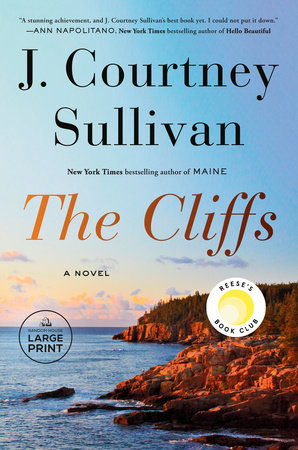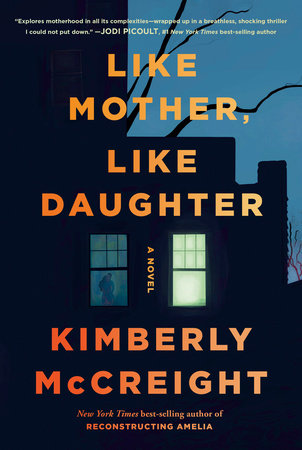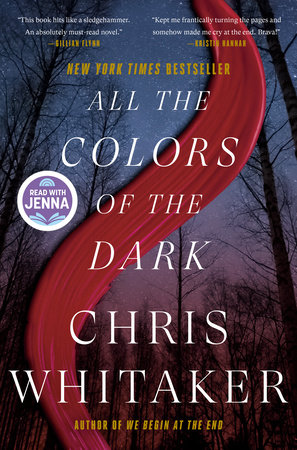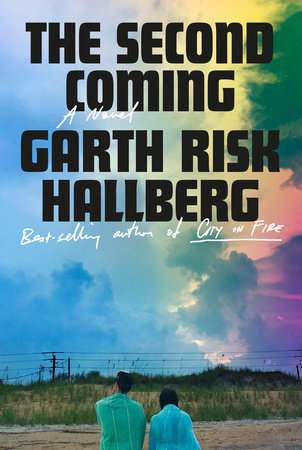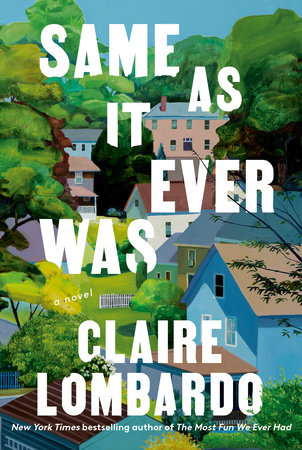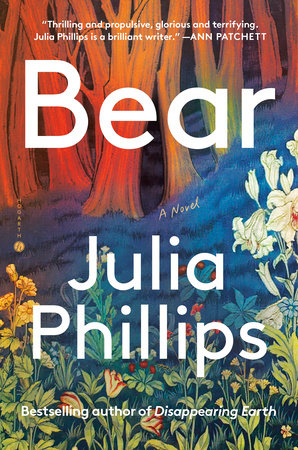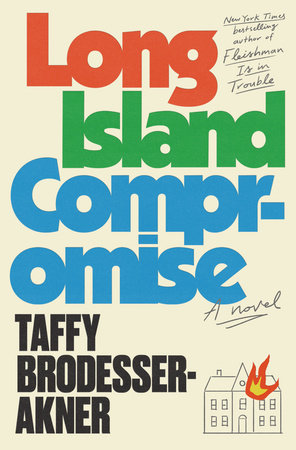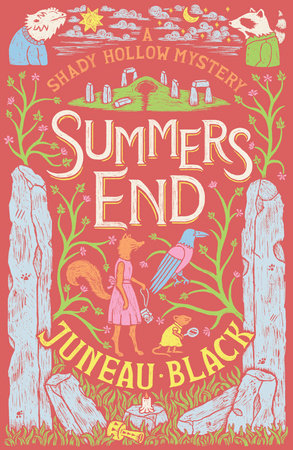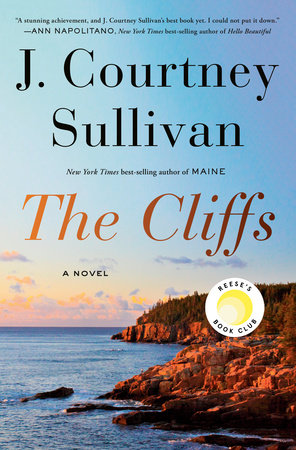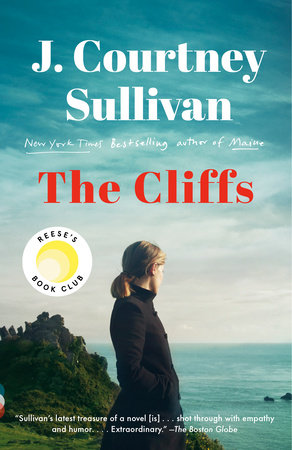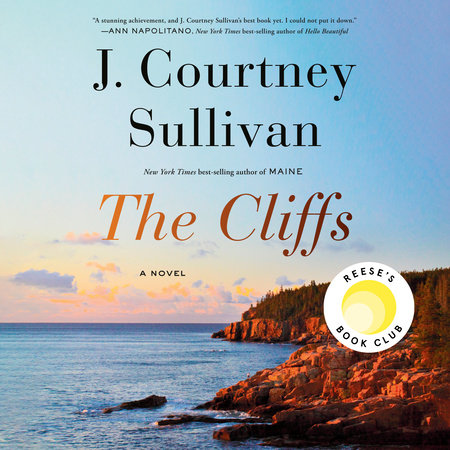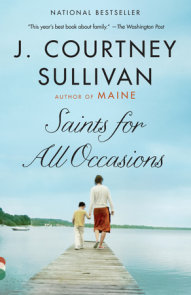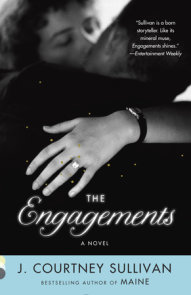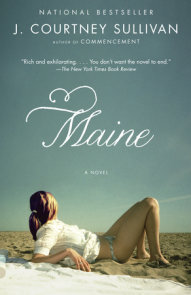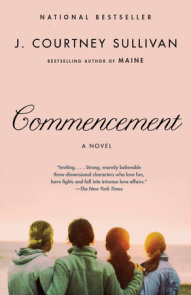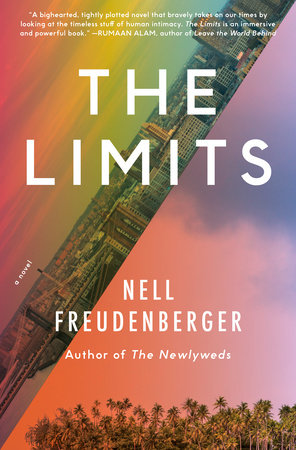Author Q&A
The Cliffs opens with a house, an old Victorian on a secluded seaside cliff in Maine, which serves as the frame for the book as you trace its history—as well as that of the land it sits on and the people who live there—from the present day all the way back to the original inhabitants of Maine, the Wabanaki. Did you always know the house was going to frame the narrative in this way?
Oh yes, the whole thing started with a house. Two houses, actually, located half a mile apart from one another, in southern Maine. The first, an 1880 farmhouse, was for sale ten years ago when my husband and I were newly married. We briefly thought of giving up our life in New York and moving there. We made an offer and were then given a map of the property, on which there was a square marked CEMETERY. It turned out the original owners and their children were buried just beyond the edge of the backyard grass, in a wooded area. Once I knew the gravestones were there, I realized I could see them from the kitchen window.
This became a topic of debate among our friends—would you be okay having a cemetery in your backyard? People felt strongly, one way or the other. To me, it felt like an extreme form of what is always true in New England: The past intersects with the present everywhere you look, whether you see it or not.
The other house that inspired me was a gorgeous, purple Victorian overlooking the ocean, fully furnished, and mysteriously abandoned. Every summer, my friend Melissa and I would look through the windows and wonder what had happened to the people who lived there. Then one year we arrived to find the house gone, a new, enormous foundation dug in its place. I was inexplicably crushed. In real life, I could never afford to save that magnificent old house. But in fiction, I could and I did. Jane, the protagonist in The Cliffs, discovers this exact house (down to the furnishings) as a teenager and it becomes her refuge from a difficult home situation and a town where she doesn’t fit in. Twenty years later—her career and marriage in shambles due to a massive mistake on her part—Jane returns to Maine and finds the house drastically changed. It comes to play an unexpected role in her adult life, too.
Having an old house at the center of the story was essential to its framing. In New England, there is a tendency to celebrate firsts: America’s oldest pub, or original printing press, or school. You see this in houses, too, with plaques attached by a local historical society that tell the date and name of the original owner. The plaques imply that the man named (it’s usually a man) was the first person to live on that land, when in fact he was merely the first person to build a house on it. I have long wondered about the lives of the people who came before such men. It’s one aspect of the larger story I wanted to explore in The Cliffs about the false narrative we’ve told for centuries—that history began on this continent when colonists arrived.
The novel is set in the fictional town of Awadapquit, which is inspired by Ogunquit, an area of Maine you’ve visited all your life—and still do to this day. Has your appreciation of the region changed at all while working on this novel?
Absolutely. I have mostly known Maine as a lifelong vacationer. It has always been my happy place, a place to enjoy nature and swim in the cold ocean and sit outside with friends and family, eating ice cream and lobster rolls. It is still all of those things for me, but several years ago, I started thinking more deeply about the history of the state. When you cross the state line into Maine, you see a sign that reads Vacationland. The Abbe Museum in Bar Harbor, which centers the history and culture of the Wabanaki, has on the homepage of its website: More Than Vacationland—Homeland. I wanted to dig into that.
As a kid growing up in Massachusetts, I loved visiting historic houses, like Louisa May Alcott’s Orchard House in Concord and the Forbes House Museum in my hometown of Milton, which was once home to a family of sea captains who made a fortune in the China Trade. When I started writing this book, I knew I wanted the protagonist, Jane—an accomplished and passionate archivist—to wrestle with the fact of a deeper story that needed to be told in such places.
In recent years, iconic national museums and tiny local historical societies alike have been reckoning with the roles that colonization and oppression have played in their collections. Last year, I attended an exhibit at the Forbes House Museum that looked at how this family became wealthy in part through the illegal opium trade and slave labor in the Caribbean. I don’t think that had ever been publicly acknowledged before.
In Maine, Indigenous history and the present lives of the Wabanaki are getting their due in places they previously didn’t, enriching and complicating the story of American history. The Old York Historical Society and the Historical Society of Wells & Ogunquit have put great effort into this. Last fall, I found myself returning to southern Maine almost weekly to attend walking tours hosted by the Old York Historical Society, on topics ranging from the history of colonial Maine to the legacy of slavery in York, to the 1692 Candlemas Raid, as well as the obligatory (excellent!) Halloween cemetery tour.
On a separate note, I think there is something so appealing and intriguing about people who choose to live year-round in small towns that are bustling with tourists in summer and quieter the rest of the year. For me, writing is a chance to peer into lives that will probably never be mine, and in this case, in the course of writing about Jane and her friends and family, I got to talk to lots of year-rounders—lobstermen, innkeepers, restaurant owners, local historians, and Indigenous artists and activists. As a teenager, Jane works on a lobster boat giving tours. Her best friend’s parents run an inn. She feels above this small town, in a way, but returning as a middle-aged woman, she develops a new appreciation for the place, its people and its history.
Can you talk about your research process for The Cliffs and the resources and people you turned to while you were writing?
I love doing research. Some fiction writers find it limiting, but for me, uncovering the facts about a place or time period provides so much inspiration for where a story might lead. Because The Cliffs covers many time periods and historical moments, my research was far-reaching and led me in several directions at once. It was a lot of fun, especially as I started writing the book in the summer of 2020, when the world felt very small. At that time, it was impossible to visit museums for research. Luckily, so many museums offered really robust online resources. I did a great deal of research via the online archives of the Maine Historical Society, the Maine Maritime Museum, Sabbathday Lake Shaker Village, and the Abbe Museum. When the world opened back up, I was lucky enough to visit the Abbe Museum and Sabbathday Lake in person.
I read books on a variety of seemingly disparate topics, all of which play a role in the novel. Books about Shakers, Spiritualism, mediumship, shipwrecks, and women in Maine during the Civil War. (I name them all in the acknowledgements section of The Cliffs.) The story of Archibald Pembroke’s voyage and the kidnapping of four Indigenous men in what is now called Maine was very loosely based on accounts of the 1605 voyage of George Weymouth.
By far the bulk of my research was on the Wabanaki. Both virtually and in-person, I attended talks and panel discussions featuring Wabanaki scholars and activists, and learned so much about the current state of tribal affairs from listening to them. Most importantly, I was fortunate to be introduced to Penobscot tribal elder Donna Loring, via our mutual friend, Christina Baker Kline. Donna has introduced me to a Maine I did not previously know. My education in Indigenous history, culture, and how best to be an ally in the ongoing fight for tribal sovereignty in Maine is ongoing— a lifelong practice of learning and unlearning, which has been vastly expanded by conversations and collaboration with Donna.
I also read (and highly recommend) several incredible books on the subject. Among them: Plundered Skulls and Stolen Spirits by Chip Colwell; Dawnland Voices: An Anthology of Indigenous Writing from New England edited by Siobhan Senier; Abenaki Indian Legends, Grammar and Place-Names by Henry Lorne Masta; In the Shadow of the Eagle: A Tribal Representative in Maine by Donna Loring; Women of the Dawn by Bunny McBride; The Life and Traditions of the Red Man by Joseph Nicolar; Indians in Eden by Bunny McBride and Harald Prins; The Common Pot and Our Beloved Kin by Lisa Brooks; Memory Lands by Christine DeLucia; The Voice of the Dawn: An Autohistory of the Abenaki Nation by Frederick Matthew Wiseman; Notes on a Lost Flute: A Field Guide to the Wabanaki by Kerry Hardy; Playing Indian by Philip Deloria; Night of the Living Rez by Morgan Talty; Notable Native People by Adrienne Keene; and The Age of Homespun: Objects and Stories in the Creation of an American Myth by Laurel Thatcher Ulrich.
In addition to Jane, you introduce readers to several other women over the course of the book, who live across centuries and have very different life experiences: a 1960s artist, a former Shaker living in the 1850s, and a present day medium and psychic, Clementine, who resides at a Spiritualist camp. Do you have any personal experiences with mediums or psychics? Why did you choose to explore this in the novel?
Almost everyone says they don’t believe in ghosts, but when pressed, almost everyone has some version of a ghost story. Mine, which I wrote about in Real Simple in 2018, happened when my son was an infant and his cradle started moving sideways, instead of back and forth like cradles are supposed to. There were also a lot of flickering lights involved. (My son, now six and an old soul if ever there was one, recently told me he was on the Titanic in a past life and survived, only to die tragically in a car accident two years later. If anyone’s bringing our family into contact with ghosts, it’s him.)
I was raised Catholic, but my mother was always interested in psychics. She would semi-regularly have one come to our house and give readings to all the women from our neighborhood, like other moms hosted Tupperware parties. An aura reader came once, when I was thirteen and in an angsty goth phase. She took photographs of everyone’s auras with a special camera. I remember all the adults had complex rainbows of color, while my aura was pure red.
I’m forty-two now and in recent years, several of my close friends have lost their parents. Many of them, even total skeptics, have found themselves trying to connect to their parents through mediums. I am fascinated by the stories. One friend was communicating with her mother’s spirit, when an unknown spirit came through with an urgent message for her own family. After some sleuthing, we figured out who the unknown woman was, and why she had chosen my friend. A fictionalized version of this encounter made its way into The Cliffs, and plays a big part in Jane’s story.
My friend Mira Ptacin (the namesake for Camp Mira in The Cliffs) wrote a fascinating nonfiction book called The In-Betweens, which transports readers to a Spiritualist gathering place in Maine, Camp Etna. A few years ago, Mira and her son Theo were kind enough to bring me to Camp Etna one summer day, to experience it for myself. And, because everything is connected, it turned out Donna Loring had an aunt who used to visit Camp Etna and she’d always wanted to see it, so last fall, Donna and I went together and each had a reading. (I actually had two, because, forever a skeptic, I wanted to know if both mediums would say the same things.)
This is your sixth novel. In what ways has working on this book been different from your previous novels? Are there certain themes you like to incorporate into all of your books?
I have long said that my primary obsession in fiction is the idea that the moment a woman is born determines so much of who she is allowed to become. This book might encapsulate that idea more than any other. We are always in conversation with the people who came before us, even if we don’t know their stories. I see the women in this book, separated by time and many other factors, but united by this house and the land on which it sits, as being in conversation with one another.
Themes of addiction, family secrets, female friendship, and motherhood tend to crop up in all my books, and these are all aspects of Jane’s story in The Cliffs. I’m also interested in faith and the role it plays or doesn’t in people’s lives—specifically as pertains to women within the confines of religion and spirituality.
As for the writing itself—for me, every book exists on two levels. There’s what is contained in the text, the story I’m sharing with readers, and there is the private story of whatever was happening in my life when I created it. In this way, each book is like a time capsule, conjuring all the triumphs and tribulations of the years spent writing it. My first two novels I wrote late at night and during weekends because I had a full-time job at the New York Times. Certain parts of my third novel, The Engagements, were set and researched in Paris, but written at my mother-in-law’s kitchen table in Des Moines, and for me the two will be forever linked. The backdrop of Friends and Strangers was the birth and babyhoods of my two children, and learning to write while also being a mother.
The Cliffs was my Covid book, though it is intentionally set a few years before Covid, in 2015. I needed to do that to escape what was going on day-to-day. For the first year of the pandemic, we didn’t have much childcare, so it was back to writing late at night for me. This, it turns out, is still when my brain works best and my mind is sharpest, though it makes for some very groggy mornings.
Your protagonist, Jane, is an archivist at the Schlesinger Library, which is dedicated to the history of women in America. Do you think there are any similarities between the work of an archivist and that of a novelist?
I have wanted to include the Schlesinger Library in a novel ever since I went there while researching The Engagements in 2012. It is the most incredible place, a treasure trove of individual women’s stories that, taken together, tell the larger story of women in America. Part of the collection focuses on women in advertising. A minor character (based on a real woman) in The Engagements, Dorothy Dignam, has her papers at the Schlesinger. As I was researching Dorothy, I thought a lot about the main character of The Engagements, Frances Gerety (also a real person), who wrote the line “A Diamond is Forever” and never felt that she got her due, professionally. In the process of researching and writing that novel, I came into possession of lots of fascinating materials, most of them from the house where Gerety lived until her death in 1999. (The new owner had hung onto them all that time, and generously gave them to me.) Last year, I donated her papers to the Schlesinger, where they now reside. This gives me so much joy, as I think it would make Frances pleased and proud.
As for similarities between archivists and novelists, there are lots. Maybe primarily the desire to keep history alive, while always thinking about its influence on our present moment. There is also the act of shaping a story, choosing what to include and what to omit. At the Schlesinger, they are extremely mindful of this, and strive to tell a complete story, one with a wide variety of voices and experiences.
Jane’s mother was an alcoholic, and she has her own complicated relationship with alcohol, too. Did you always know this was going to be part of Jane’s story?
Alcoholism—particularly the cyclical, destructive role it can play in a family—is something I’ve explored in several of my novels. As Jane says, telling people “my mother was an alcoholic” engenders so much sympathy. But what Jane leaves out (and isn’t quite ready to face at first) is that she’s an alcoholic too. On the surface, she is far more accomplished and together than her mother and sister, but this is one piece of her family history that she cannot shake.
I am eight years sober. Like Jane, I was a high-achieving good girl who was secretly a blackout drinker, and while I never did anything to blow up my life quite as spectacularly as she does in the novel, I certainly did regrettable things that required forgiveness from my loved ones. If you’ve never experienced a blackout, it can be hard to imagine how hours of your life, when you appeared fine to others, are entirely inaccessible to you. It’s not a hazy memory situation, it’s having absolutely no idea where you were or what you said.
Eight years is long enough to have processed the experience, but still close enough that I can conjure up my drinking days quite easily, along with the internal justifications and conversations with myself about whether or not I had a problem. Deep down, I knew the answer was yes, but I really wanted it to be no. Jane is going through a version of the same thing. I have so much empathy for her and everyone in the midst of that struggle.
What do you hope readers take away from this story?
As the world grows ever louder and stranger and scarier, I find that there is nothing better than that rare novel that will transport me to some other time and place and take me out of reality for a while. This just happened to me, with The Glass Hotel by Emily St. John Mandel, and then again with Good Material by Dolly Alderton. Two very different books, but with the same wonderful effect. I hope The Cliffs has this effect on someone out there. I hope it keeps them up long past their bedtime, and transports them for a while.
